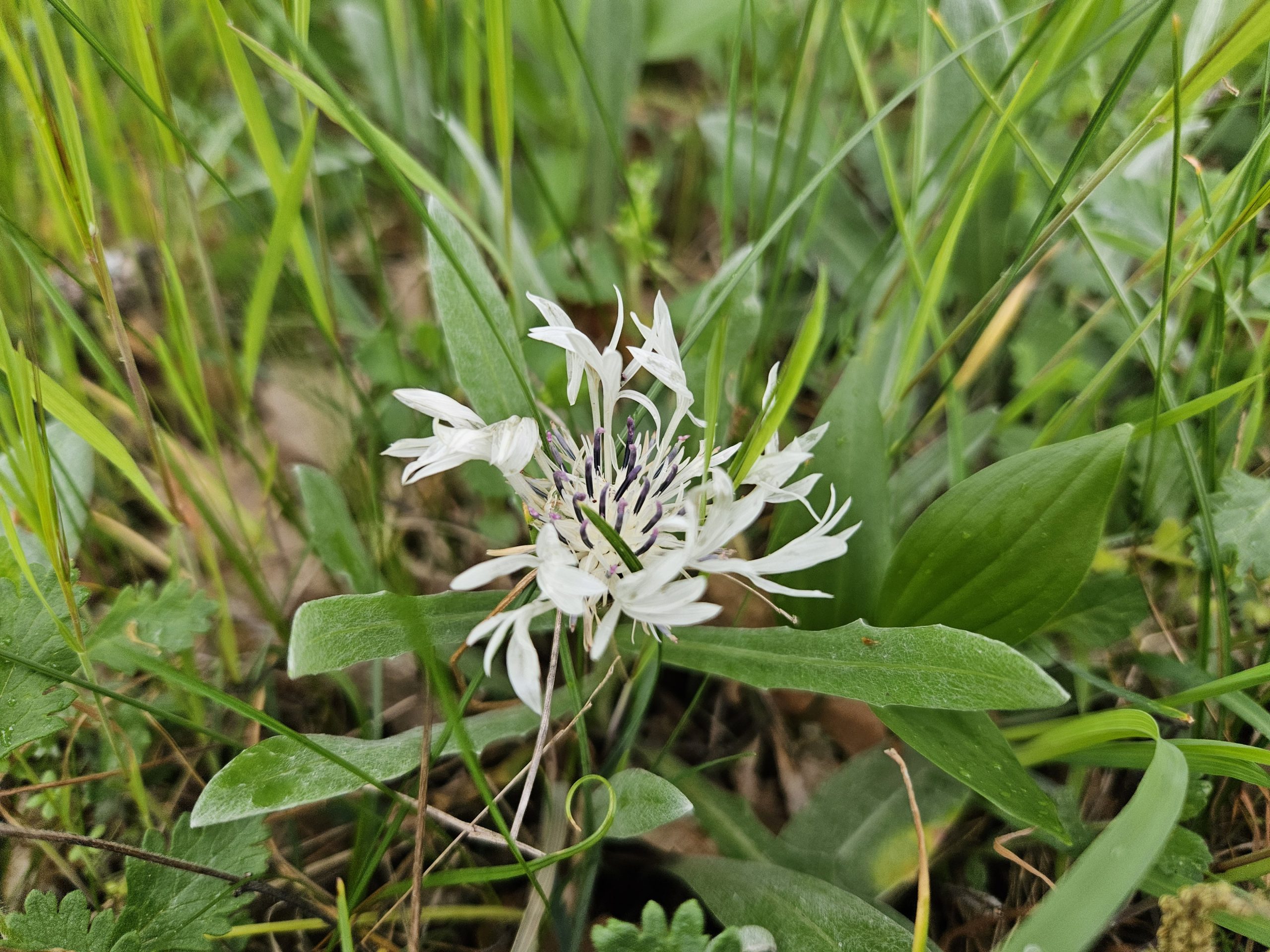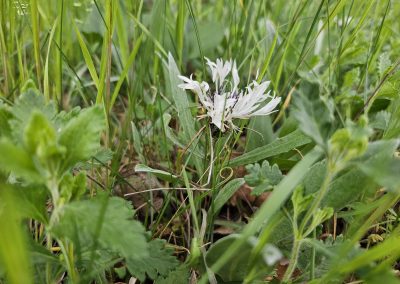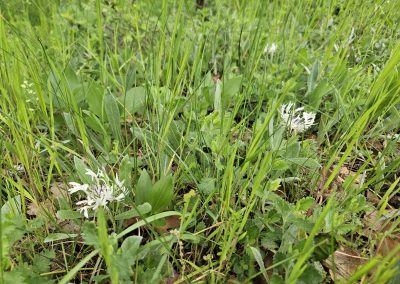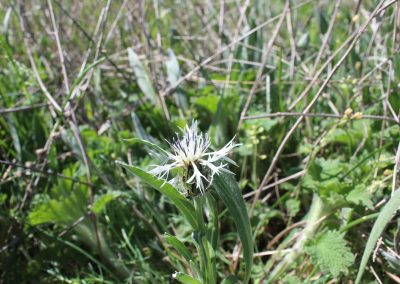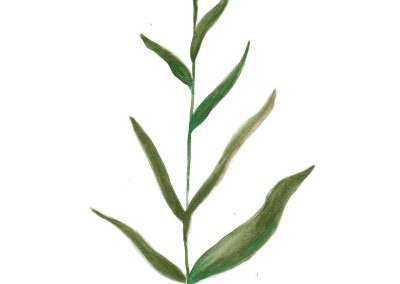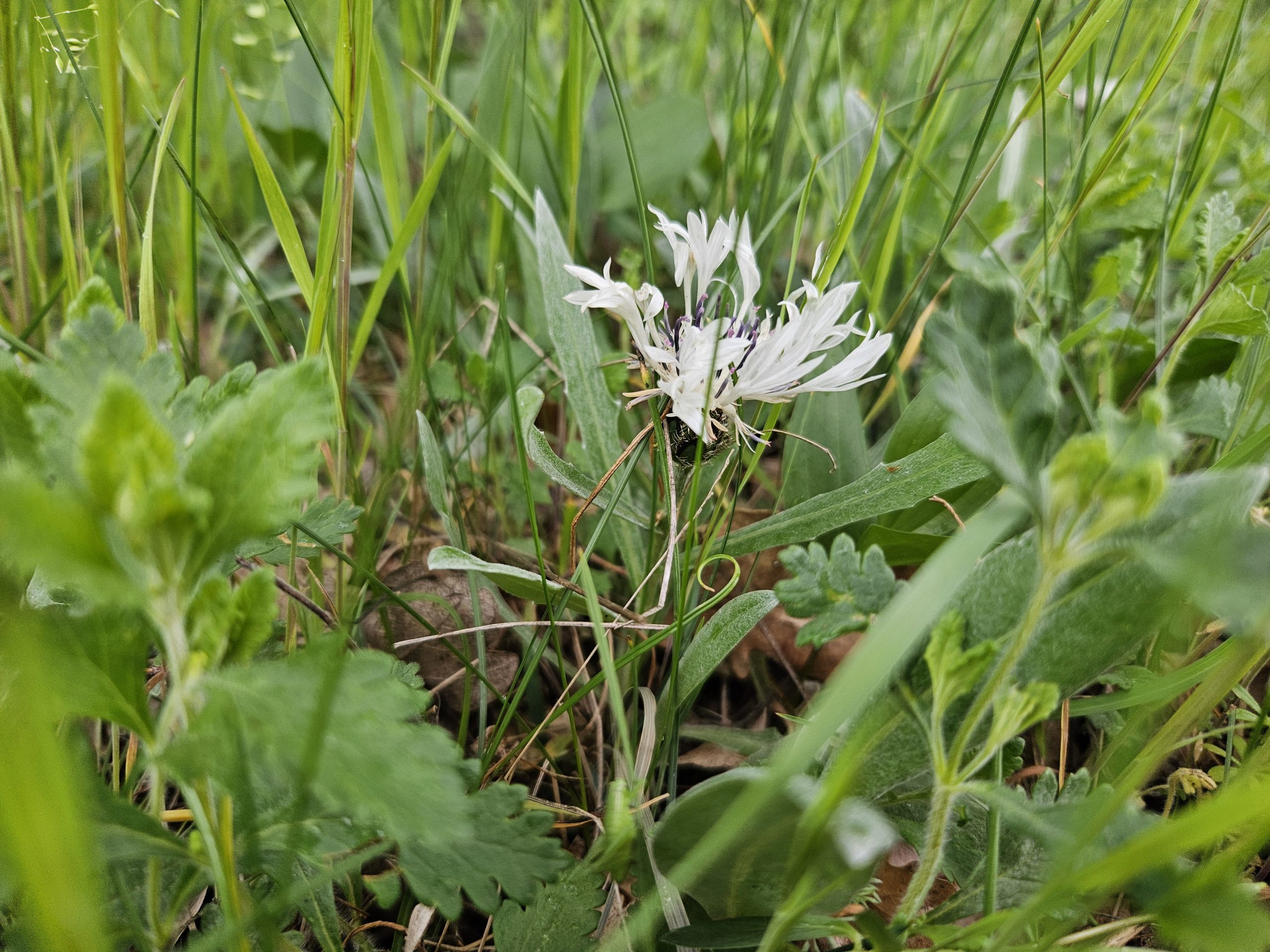Centaurea Napulifera
Scientific description
Taxon: Angiospermatophyta (Magnoliophyta)
Class: Dicotyledonatae (Magnoliatae)
Subclass: Asteridae
Order: Asterales (Compositales)
Family: Asteraceae (Compositae)
Common name: Feverfew
Origin: Southeastern Europe, the Balkan Peninsula, and Romania
Description:
It is an annual herbaceous plant, a thermophilic species that loves light. A taproot extends underground, with a well-developed root system. The stem is erect, up to 30 cm tall, leafy, woolly, tomentose, simple, or very rarely branched. Basal leaves, but also lower ones, are petiolate, elongated, sinuate-dentate or lyrate, hairy, and glandular. The central flowers are white, and the marginal ones are blue, with a diameter of up to 3 cm, gathered in bunches. It blooms from April to June.
Propagation: Seeds, stolons
Ecology:
Often found on grassy slopes, in meadows, shrubs, and forest edges. It thrives on slopes, in sunny, dry, and rocky areas.
Use:
It is used as an ornamental plant, with horticultural importance, used for landscaping courtyards, gardens, and rockeries. In the past, it was used as a medicinal plant for treating fatigue, as an antiseptic, and antispasmodic.
Threat: It is a rare plant due to excessive grazing and agriculture.
Încrengătura: Angiospermatophyta (Magnoliophyta)
Clasa: Dicotyledonatae (Magnoliatae)
Subclasa: Asteridae
Ordinul: Asterales (Compositales)
Familia: Asteraceae (Compositae)
Denumire populară: mărăcine, scaiul dracului
Originea: sud-estul Europei, peninsula Balcanică și România
Descrierea:
Este o erbacee anuală. Specie termofilă și iubitoare de lumină. Cu sistem radicular bine dezvoltat, rădăcină pivotantă. Tulpina este erectă, cu înălțimi până la 30 cm, este foliată, lânoasă, tomentoasă, simplă sau foarte rar ramificată. Frunzele bazale, dar și cele inferioare pețiolate, alungite, sinuate-dentate sau lirate, păroase și glandulare. Florile centrale sunt de culoare albe, iar cele marginale azurii, cu diametru de până la 3 cm, adunate în ciochini. Înflorește din aprilie până în iunie.
Înmulțire: Semințe, stoloni
Ecologia:
Frecventă pe coastele înierbate, prin pajişti, tufărişuri și margini de pădure. Vegetează foarte bine pe versanți, zone însorite, uscate și stâncoase.
Utilizare:
Este și o plantă ornamentală, cu importanță horticolă, pentru amenajarea curților, grădinilor și stâncăriilor. În trecut era folosită ca plantă medicinală, bună pentru tratarea oboselii, antiseptic și antispastic.
Pericol: Este o plantă rară, datorită pășunării excesive și agriculturii.
Γένος: Angiospermatophyta (Magnoliophyta)
Τάξη: Δικοτυλήδονα (Magnoliatae)
Υποκατηγορία: Asteridae
Τάξη: Asterales (Compositales)
Οικογένεια: Asteraceae (Compositae)
Λαϊκή ονομασία: αγκάθι, γαϊδουράγκαθο του διαβόλου
Καταγωγή: Νοτιοανατολική Ευρώπη, Βαλκανική χερσόνησος και Ρουμανία
Περιγραφή:
Ετήσιο βότανο. Θερμόφιλο και φωτοαγαπητικό φυτό. Με καλά ανεπτυγμένο ριζικό σύστημα, ρίζα πασσαλώδη. Ο βλαστός είναι όρθιος, ύψους έως 30 εκ., φυλλώδης, μαλλιαρός, τοματοειδής, απλός ή σπάνια διακλαδισμένος. Τα βασικά και κατώτερα φύλλα είναι μίσχο, επιμήκη, ελικοειδή ή λυρικά, τριχωτά και αδενικά. Τα κεντρικά άνθη είναι λευκά, ενώ τα περιθωριακά γαλάζια, με διάμετρο έως 3 εκ., συγκεντρωμένα σε συστάδες. Ανθίζει από Απρίλιο έως Ιούνιο.
Πολλαπλασιασμός: Σπόροι, διακλαδώσεις
Οικολογία:
Συχνό σε δασωμένες ακτές, λιβάδια, θαμνώνες και παρυφές δασών. Αναπτύσσεται καλά σε πλαγιές, ηλιόλουστες, ξηρές και βραχώδεις περιοχές.
Χρήσεις:
Καλλωπιστικό φυτό με κηποτεχνική σημασία, για τη διαμόρφωση αυλών, κήπων και βραχόκηπων. Στο παρελθόν χρησιμοποιήθηκε ως φαρμακευτικό φυτό, καλό για την αντιμετώπιση της κόπωσης, αντισηπτικό και αντισπασμωδικό.
Κίνδυνος: Σπάνιο φυτό λόγω υπερβόσκησης και γεωργίας.
Taxon : Angiospermatophyta (Magnoliophyta)
Classe : Dicotyledonatae (Magnoliatae)
Sous-classe : Asteridae
Ordre : Asterales (Compositales)
Famille : Asteraceae (Compositae)
Nom commun : Grande Camomille
Origine : Europe du Sud-Est, péninsule des Balkans et Roumanie
Description :
Centaurea Napulifera est une plante herbacée annuelle, thermophile et fortement dépendante de la lumière. Elle possède une racine pivotante qui s’enfonce profondément sous terre, avec un système racinaire bien développé. Sa tige est dressée, atteignant jusqu’à 30 cm de hauteur, feuillue, laineuse, tomenteuse, simple ou très rarement ramifiée. Les feuilles basales, ainsi que les feuilles inférieures, sont pétiolées, allongées, sinuées-dentées ou lyrées, velues et glandulaires. Les fleurs centrales sont blanches, tandis que les fleurs marginales sont bleues, atteignant un diamètre de 3 cm, regroupées en bouquets. La floraison a lieu d’avril à juin.
Multiplication : Graines, stolons
Écologie :
On trouve souvent cette plante sur des pentes herbeuses, dans les prairies, les buissons et en lisière de forêt. Elle prospère sur les pentes ensoleillées, sèches et rocheuses.
Utilisation :
Plante ornementale de grande valeur horticole, utilisée pour l’aménagement des cours, jardins et rocailles. Autrefois employée en phytothérapie pour traiter la fatigue, comme antiseptique et antispasmodique.
Menaces : Plante rare en raison du pâturage intensif et de l’agriculture.
Creative writing inspired by Centaurea Napulifera
Written by Petrescu Alexandru
The Curse of Dawn
A long, long time ago, when mountains still harbored gods' secrets and the wind was a messenger from realm to realm, there lived a priestess, Doria. She was pale and modest, with blue eyes like winter skies. Doria possessed the special gift of listening to the songs of stars. Locals in the valley called her "The Maiden of the Dawn" because she would go up the cliffs every morning, frost-covered, to pray and invoke the light.
But in one spring, the light did not return. The dawns never rose, and shadows lingered long after night should have fled. It was said that Tarbos, the god of forgetfulness, had stirred himself out of his sleep deep in the earth and stolen the first light of day. Fear came upon the villages, and even the mountain springs froze.
Weak as she was, Doria climbed the highest mountain—Mount Lunaria—where Tarbos was rumored to possess his power. Three nights and three days, she prayed into the biting wind, until the god arrived in his fury. He offered her a choice: let darkness rule, or surrender her heart for the return of dawn. Without faltering, Doria chose sacrifice.
Where her heart landed on the cold earth, only a single flower bloomed—silver-stemmed, dressed in soft violet and bright blue. It was unlike all others, blooming on the desolate cliffs, but only at sunrise. The locals called it Centaurea napulifera, and they believed that it held Doria's last breath and promise.
Even now, the flower still blooms where light meets frost, where silence is sung—informing the world that even in the darkest hour, one human's courage can bring back the dawn.


